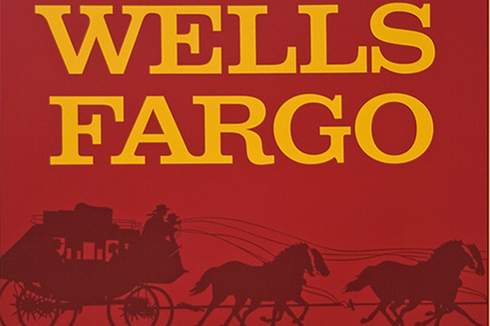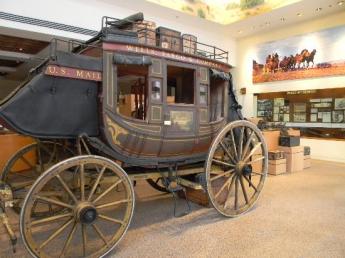Related Topics
No topics are associated with this blog
Museum of Banking

|
| Wells Fargo |
Caitlin Phillips, the curator of Wells Fargo's new museum of banking, recently entertained the Right Angle Club with a description of her museum, and the history it reflects. Wells Fargo hasn't had an office in Philadelphia for fifty years, but it had a long and interesting relationship before that, and it wants Philadelphia to refresh its memories.
Wells Fargo sounds like San Francisco to most of us, and indeed its first branch was located in San Francisco. However, both Wells and Fargo were New York bankers who scarcely had visited California in their whole lives. They had started American Express and saw a great opportunity developing in the 1849 Gold Rush, but American Express wasn't interested. So the two innovators left that company and formed another, The Wells Fargo Express Company. The great opportunity was to get that gold dust from Sutter's Mill outside Sacramento, back to the East Coast where it could be made into something useful, like gold bars. The national mint was located in Philadelphia, so somehow that gold dust had to get from there to here, with lots of robbers and hostile Injuns, in between. Accordingly, the two entrepreneurs established a Philadelphia branch at 4th and Chestnut, and eventually over 10,000 branches in other places. They established the Pony Express for a couple of years, with small young riders willing to take their chances with an exciting new job; for its part, Wells Fargo tended to select young small-statured orphans without many family connections as the most suitable candidates for the job. In spite of its fame, the pony express was not a commercial success, and was soon replaced by stage coaches, then eventually by railroads. In 1918, the federal government nationalized the railroads and express companies, presumably as a gesture of patriotic fervor. They were eventually restored to private ownership in 1928, but by then most express companies had found other things to do.

|
| Wells Fargo Museum |
Adams Express in Baltimore became a closed-end investment company. Railway Express dwindled as the railroads themselves declined. While American Express floundered for a while, it thrived when it settled down in the credit card business. Wells Fargo and four other banks formed Master Card and did the same, but it was fortunate to be in a better position than the other express companies. When the 1906 San Francisco earthquake and fire destroyed thousands of buildings, the Wells Fargo home office was also burned to the ground. But by luck, the vault and all its contents were spared, so Wells Fargo was suddenly the dominant feature of West Coast banking and exploited its advantage. With ample assets, it was able to buy up many other banks and exploit another development. It was becoming clear that large banks had a serious advantage over small ones, a fact its competitors criticized as being "too big to fail". In an era when bigger was better, Wells Fargo was able to buy up hundreds of small banks, eventually becoming the third or fourth largest bank in the country. In fact, its most serious domestic competitors are in the shadow banking industry of money market funds, repo's, derivatives and so on. There is plenty of international competition in London, Tokyo and so on, and political parties are beginning to take sides between what is mysteriously termed commercial banking and investment banking. As long as the present financial crisis continues, it will probably remain unclear how this struggle will turn out. And therefore remain unclear whether the loss of all those banks on Chestnut Street was a tragedy for Philadelphia, or good riddance.
Adams Express in Baltimore became a closed-end investment company. Railway Express dwindled as the railroads themselves declined. While American Express floundered for a while, it thrived when it settled down in the credit card business. Wells Fargo and four other banks formed Master Card and did the same, but it was fortunate to be in a better position than the others express companies. When the 1906 San Francisco earthquake and fire destroyed thousands of buildings, the Wells Fargo home office was also burned to the ground. But by luck, the vault and all its contents were spared, so Wells Fargo was suddenly in a position to become the dominant feature of West Coast banking and exploited its advantages. With ample assets, it was able to buy up many other banks, and exploit its size, another new feature. It was becoming clear that large banks had a serious advantage over small ones, a fact its competitors criticized as being "too big to be allowed to fail".In this new era when bigger was better, Wells Fargo was able to snowball, buying up hundreds of small banks, eventually becoming the third or fourth largest bank in the nation. In fact, its most serious domestic competitors are now in the shadow banking industry of money market funds, repo's, derivatives and so on. There is plenty of international competition in the big banks of London, Tokyo, and other big cities, and political parties are beginning to take sides between what is mysteriously termed commercial banking and investment banking. As long as the financial crisis continues at present, it will probably remain unclear how this struggle will turn out.
Adams Express in Baltimore became a closed-end investment company. Railway Express dwindled as the railroads themselves declined. While American Express floundered for a while, it thrived when it settled down in the credit card business. Wells Fargo and four other banks formed Master Card and did the same, but it was fortunate to be in a better position than the other express companies. When the 1906 San Francisco earthquake and fire destroyed thousands of buildings, the Wells Fargo home office was also burned to the ground. But by luck, the vault and all its contents were spared, so Wells Fargo was suddenly the dominant feature of West Coast banking and exploited its advantage. With ample assets, it was able to buy up many other banks and exploit another development. It was becoming clear that large banks had a serious advantage over small ones, a fact its competitors criticized as being "too big to fail". In an era when bigger was better, Wells Fargo was able to buy up hundreds of small banks, eventually becoming the third or fourth largest bank in the country. In fact, its most serious domestic competitors are in the shadow banking industry of money market funds, repo's, derivatives and so on. There is plenty of international competition in London, Tokyo and so on, and political parties are beginning to take sides between what is mysteriously termed commercial banking and investment banking. As long as the present financial crisis continues, it will probably remain unclear how this complex struggle is turning out. And therefore remain unclear whether the loss of all those banks on Chestnut Street was a tragedy for Philadelphia, or good riddance.
Originally published: Friday, June 07, 2013; most-recently modified: Friday, May 24, 2019